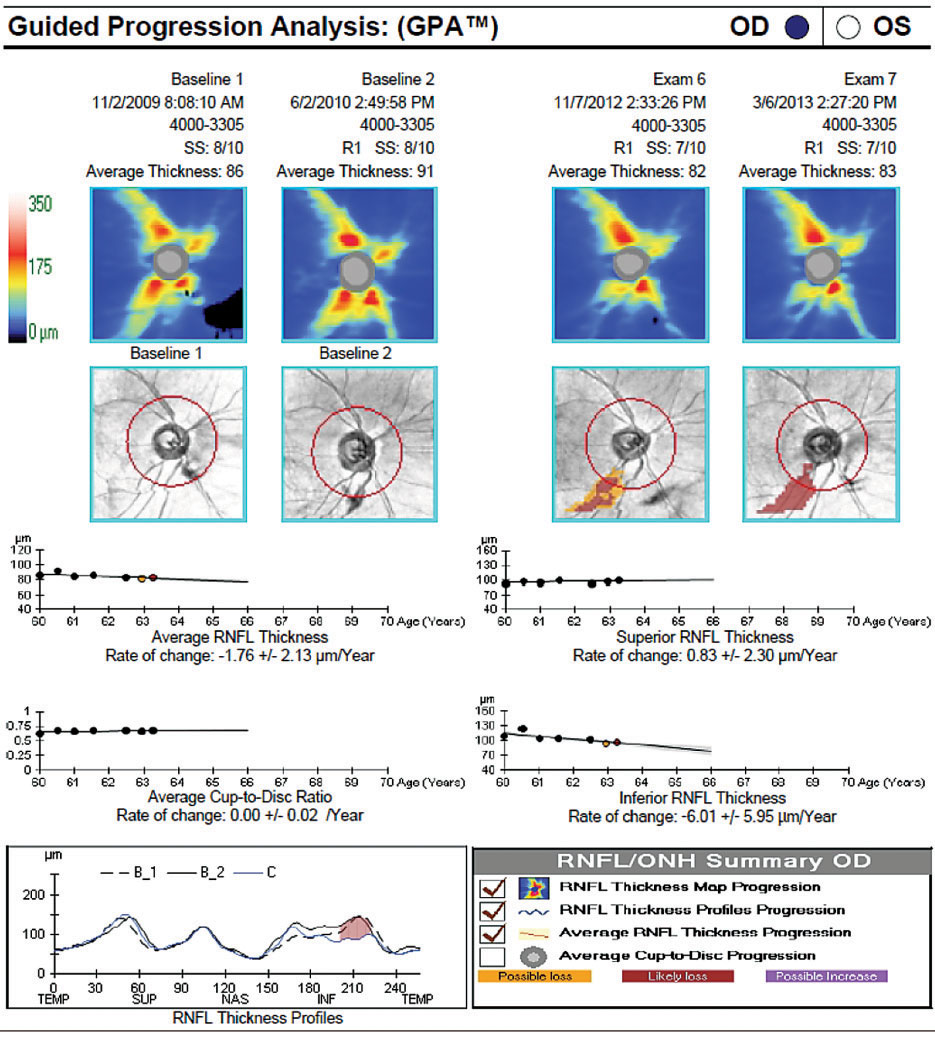 |
| African American race, cataract or glaucoma surgery and more frequent visit/testing were the clinical factors associated with long-term RNFLT variability on OCT in glaucoma patients. Photo: Danica J. Marrelli, OD. Click image to enlarge. |
Although considered less prone to variation than visual field (VF) testing, OCT scans of retinal nerve fiber layer thickness (RNFLT) measurement have shown a wide range of test-retest variability in prior studies. The factors contributing to a RNFLT variability haven’t been investigated as much, so in a new study researchers examined various clinical factors at play in glaucoma. They found that the main influences on RNFL thickness variability were African American race, history of cataract or glaucoma surgery and more frequent visits/testing.
A total of 1,140 glaucoma eyes with two or more years of care and four follow-up visits were included. Variability was calculated per-visit across longitudinal follow-up. Clinical factors examined included general demographics, baseline ocular measurements, history of cataract extraction (CE) or glaucoma surgery, scan quality, baseline RNFL thickness and subsequent thinning rate, follow-up duration and visit/testing frequency.
It’s possible the greater OCT variability of African Americans may be partially related to the worse glaucoma severity and the faster deterioration. “Of note, a potentially delayed detection of glaucoma progression in African Americans due to the greater VF variability has been suggested,” the authors explained in the study. “With a similarly greater variability for RNFLT, such differences should be considered and, perhaps, managed with more frequent testing when evaluating glaucoma in this population.”
In the baseline and full models, a worse baseline visual field mean deviation showed a small but significant association with greater RNFLT variability. An association was found between a more positive thinning rate and greater variability, which interestingly may seem to suggest RNFLT may be reliable when evaluating rapidly progressing eyes, according to the authors.
Clinically, it might indeed be more difficult to detect progression when the slope of RNFL thickness change is small, which can make differentiation between noises and true changes more challenging, the authors noted.
“In general, these suggest the incorporation of other clinical tests on top of OCT when assessing glaucomatous progression. Additionally, clinicians should be aware of possible false-negative results when a disproportionately small/slow change in RNFLT was found despite other symptoms and signs suggesting true progression.”
A greater RNFLT variability was found to be associated with both cataract and glaucoma surgeries, which could be related to the rise in RNFLT measurement after cataract extraction or the presence of a significant cataract during the follow-up period, the authors noted in their article on the research.
“Considering the more prominent effects of intervening surgeries on RNFLT variability, the establishment of a new imaging baseline after the procedures might be beneficial for subsequent progression evaluation for patients receiving intervening CE and/or glaucoma surgeries,” the authors explained in the study.
These findings suggest that by performing more frequent monitoring, clinicians will likely be able to detect structural progression by OCT more accurately, which can be applied to cases that have higher risk of measurement fluctuation.
“Increasing the testing frequency, especially in eyes at risk of higher measurement variability, and resetting of baseline imaging after intervening procedures may help to more reliably detect OCT progression,” the authors concluded.
Wu JH, Moghimi S, Walker E, et al. Clinical factors associated with long-term OCT variability in glaucoma. Amer J Ophthalmol. July 10, 2023. [Epub ahead of print.] |

